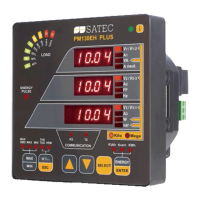15
5 DIRECT READ/WRITE REQUESTS
5.1 General
This chapter describes the instrument data locations that are addressed directly using data location
indexes. These locations can be accessed by using universal direct read/write requests instead of specific
ASCII requests. A data index is a 4-digit hexadecimal number, which actually comprises a two-digit data
group identifier followed by a two-digit location offset within a group. All data are transmitted in ASCII
hexadecimal notation. Negative numbers are transmitted in 2-complement code.
5.1.1 Long-Size Direct Read/Write
Table 5-1 Read Request
Message type (ASCII)
A
Message body (hexadecimal)
Request
Field Offset Length Parameter Range
1 0 4 Start data index to read 0000h - FFFFh
2 4 2 The number of contiguous data items to read 1-30 (01h - 1Eh)
Response
Field Offset Length Parameter Range
1 0 2 Number of data items in the message 1-30 (01h - 1Eh)
2 2 8 Data #1 value
3 10 8 Data #2 value
... ... ... ...
31 234 8 Data #30 value
Table 5-2 Write Request
Message type (ASCII)
a
Message body (hexadecimal)
Request/Response
Field Offset Length Parameter Range
1 0 4 Data index to write 0000h - FFFFh
2 4 8 Data value to write
In long-size direct read/write messages, all data items are read and written as long signed integers, which
are represented in messages by 8-digit hexadecimal numbers, regardless of the actual data size.
By using a long-size direct read request, up to 30 contiguous parameters can be read at once. A write
request allows for writing only one data location at a time.

